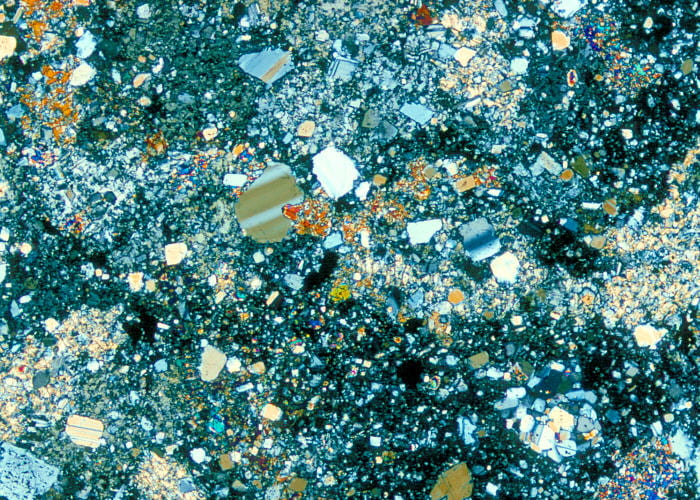Lunar thin section 65015
This is an breccia that was incompletely melted during impact heating. It consists of a matrix of crystallized liquid, now mostly pigeonite and plagioclase, enclosing a variety of monominerallic and polycrystalline fragments. This was collected by the Apollo 14 mission to the Fra Mauro crater, on the northeastern margin of Mare Nubium. The material represents part of the Mare Imbrium ejecta blanket. It has been dated at ~3.93 Ga.
|
|
Compared to other breccias, this one is strikingly light-colored. That is because it contains no dark glass and little very fine-grained opaque material. The opaque material has crystallized into larger crystals, which in aggregate do not make the rock appear so dark as when it is fine-grained and dispersed. The fragmental breccia texture, however, survived melting. Some of the clasts, for example the larger one in the lower right, are annealed lithic fragments. In cross polarized light the patchy, poikilitic pigeonite in the matrix can be seen enclosing fragments and new crystals of plagioclase and rare augite and olivine. The predominance of low-Ca pyroxene, abundance of plagioclase, and low olivine and opaque content indicates that this sample consists of reworked highland rocks. Field width is 4 mm.
Views in plane- and cross-polarized light.
|
|
|
This close-up view shows some of the clasts in detail. The large plagioclase crystal to the upper left seems to have an overgrowth of plagioclase marked by a faint, dark line paralleling the grain margin. A few other grains also have hints of overgrowths. Note that the opaques (mostly ilmenite) enclose other crystals. This shows in detail the poikilitic pigeonite crystals. The grain toward the bottom with bright yellow birefringence is an augite crystal. Field width is 1.6 mm.
Views in plane- and cross-polarized light.
|
|
|
Close-up view of the annealed feldspathic rock fragment seen in the first image. Notice how the enclosed pyroxene crystals are partly shaped by contact with adjacent plagioclase. The annealed texture of this anorthositic fragment is obvious, with abundant 120° grain boundary intersections. The mafic minerals are augite, possibly with some olivine. Field width is 0.8 mm.
Views in plane- and cross-polarized light.
|






